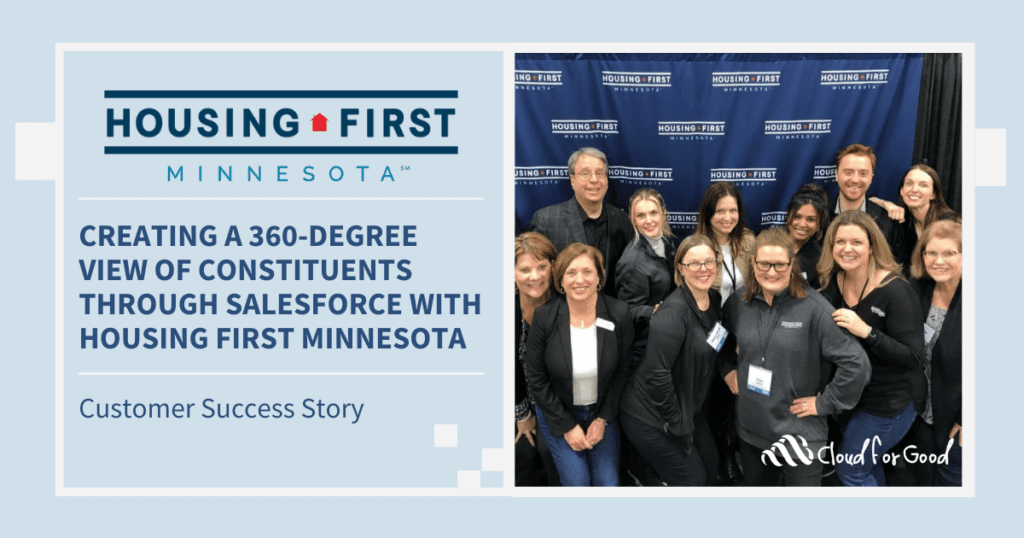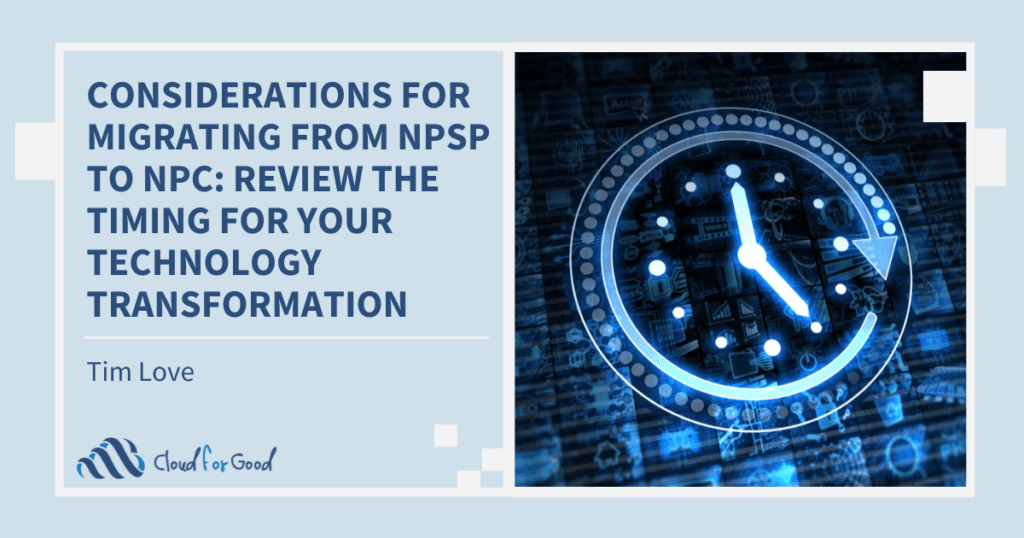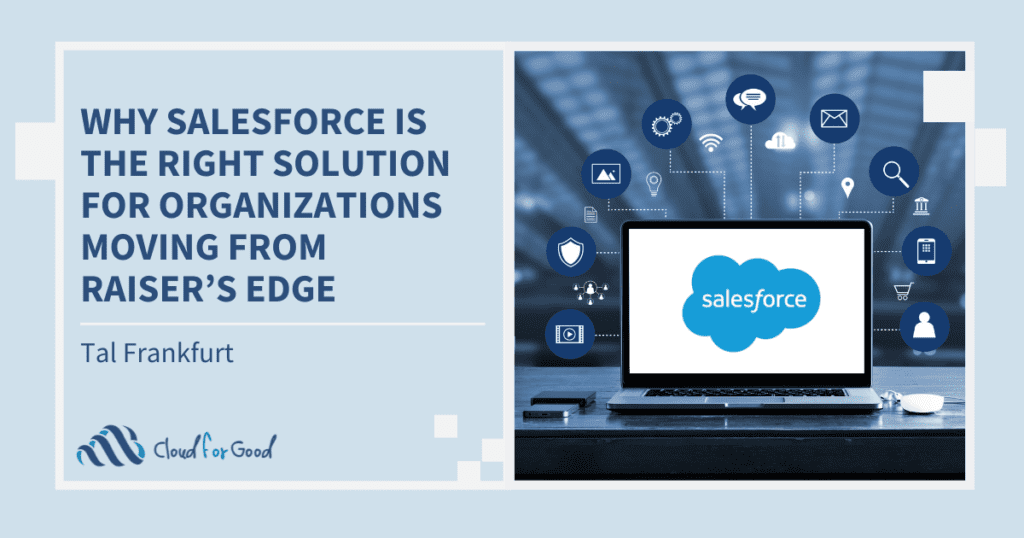Salesforce technology supporting the nonprofit sector has evolved greatly during my 10 years within the ecosystem. Each year ushers in new advancements that build upon the Salesforce Advantage provided through the world’s #1 CRM platform. One product, in particular, the Nonprofit Cloud, stands out as a revolutionary tool for nonprofit organizations that only continues to get better. While the NGO Connect (NGOC) product has provided nonprofits with support for the better part of a decade, its lack of flexibility and ecosystem involvement limit its effectiveness and make it an inferior option within today’s landscape when compared to Nonprofit Cloud. If you’re currently on NGOC, it might be time to consider making the leap to the Nonprofit Success Pack (NPSP) data architecture.
Empowering the End-User
Cloud for Good stopped recommending NGOC to its clients (and started converting NGOC clients to NPSP) in 2015 for good reason: NGOC limited our enterprise clients and Salesforce’s investment in the NPSP product was simply impossible to ignore. Fueled by an exponentially growing team of developers, NPSP quickly became, and continues to be, the go-to data architecture for nonprofit organizations due to its ability to address common challenges and handle change in stride. Equipped with advanced configuration capabilities like trigger handlers and the ability to automate soft credits, NPSP features far superior customization and maintenance abilities when compared to NGOC. These advantages are enhanced by Open Source Community Sprints that allow end-users to provide their feedback and contribute to the features and functionality within NPSP in real-time. This symbiotic relationship created between Salesforce and its community cannot be understated when considering the importance of an organization’s ability to adapt and evolve as the nonprofit landscape changes over time.
Continual expansions of NPSP, such as the upcoming advancements to payment services, giving pages, and integrated engagement hub included in Salesforce.org Elevate, represent one of NPSP’s greatest advantages. Salesforce’s commitment to NPSP is evident in the continual support and new features consistently added to the product. With NPSP, the Salesforce community consistently finds itself impacting new business and advancing the overall direction, utilizing the more than 40,000 customers of the product to build upon its industry-standard data model. The biggest advantage of NPSP over NGOC is the scalable nature inherent to NPSP’s configurability. Through the customizability and supreme management capabilities, NPSP provides organizations with a platform powerful enough to run their entire mission, and once Elevate is released, there will be even more than feature parity between the two products. NPSP has quickly cemented itself as the go-to option for any nonprofit organization looking to assimilate into the Salesforce ecosystem.
NPSP’s flexibility is going to be key for any forward-thinking organization. Consider the ability to manage affiliations and relationships in regard to nonprofit organizations, like JA Worldwide or Ounce of Prevention Fund. NPSP is used as the data model for these organizations so that they have the ability to expend their usage of salesforce beyond fundraising. The migration from NGOC to NPSP allowed these organizations and many others the ability to manage the overlap between donors and volunteers or other groups of constituents.
How Do NGOC and NPSP Differ?
There are a few key differences between NGOC and NPSP that you’ll want to understand before deciding to migrate your data:
1. NPSP was built with nonprofit organizations specifically in mind. As the nonprofit landscape has changed, NPSP has steadily evolved in step. Nonprofit organizations rely on connectivity and shared business processes between fundraising, accounting, program management, etc., and NPSP addresses the common challenges associated with those processes while handling change seamlessly. Salesforce, by nature, is an extensible platform, yet NGOC is unable to accommodate cross-departmental data sharing or integrate many third-party applications. NPSP enables shared business processes across departments and scalable solutions not possible within NGOC.
2. The NPSP payment object is streamlined and simplified. With NGOC, both payments and gifts are represented as one Opportunity object, so you’re forced to use the Opportunity object for all payment and transaction management. With NPSP, the processing and management of recurring donations, pledges, grants, and multi-payment major gifts are streamlined thanks to an interface that maps payment fields to opportunity fields. NGOC’s hierarchy of opportunities can result in confusion when generating reports, processing records, and creating roll-up fields. Both NPSP and NGOC provide organizations with the ability to schedule payments, report revenues, edit the dates associated with future payments, and manage payment commitments. However, the introduction of Salesforce.org Elevate coming as part of Salesforce’s Summer ’20 Release will tip the scales in NPSP’s favor even further. Operating as a fully integrated solution for payment services, featuring giving pages, an engagement hub, and cross-cloud integration, Elevate will allow organizations to connect directly with payment providers to better manage payments and convert visitors into advocates.
3. NPSP features Table-Driven Trigger Management. This valuable tool was completely missing in NGOC. While there are custom settings within NGOC to prevent or avoid conflicts, the extent of NPSP’s settings is much larger. The trigger management within NPSP is robust and intelligent, even going so far as to control the order in which its own triggers, and other packages, fire. NGOC’s lack of this management functionality speaks to the lack of consistent updates and support for the product, as well as an absence of the ongoing development that NPSP greatly benefits from.
4. NGOC lacks data model options. NPSP supports multiple account models, such as Household, 1:1, and Bucket model. This makes NPSP better for organizations with existing Salesforce implementations, or with specific business models best served by some of these data models. NGOC also lacks a single installer and can run into issues if its multiple packages are not installed in the correct sequence. There are more pitfalls for your data that could potentially require vendor support, while NPSP is able to operate more self-efficiently.
5. NGOC suffers from storage limitations. A few places within NGOC’s architecture create more records than NPSP to track the same data. For example, the Address architecture in NGOC includes the Address, Contact Address, and Account Address. This means that at least 3 records are used to track a single address for an individual. Similarly, the use of Opportunity hierarchy for pledges and major gifts can mean having additional layers of Opportunity records to track data that the NPSP handles just on an Opportunity with related payments. Finally, NGOC creates Summary records for contacts and accounts, which can quickly balloon in terms of storage. The NPSP leverages customizable roll-up summary fields on the Contact and Account to provide those summary details instead.
NGOC was built to provide widespread support through a lengthy list of features. This approach of providing “everything for everyone” invariably leads to issues of inflexibility when attempting to run an entire mission on one central platform. The need to customize and configure according to new releases and developments within the ecosystem will no doubt come along. Limitations inherent to NGOC’s inflexibility are absent within the open-source customizability fundamental to NPSP and the Salesforce CRM experience. Understanding your organization’s growth plan and scope of need is critical when considering the differences between the NGOC and NPSP products.
Utilizing a Partner to Facilitate Your Implementation
When it comes to taking the step from NGOC to NPSP, there is always a benefit to working with a partner as opposed to undertaking the task independently. Migrating your data over is almost always more complicated than you think; the process is much more than simply extracting your data into an Excel spreadsheet and uploading it into Salesforce. The advantage of working with a partner like Cloud for Good is that we’ve conducted these implementations time and time again. Not only do we have a proven track record of migration success, but we’ve also created our very own migration accelerators that utilize pre-built mapping logic to reduce time and minimize interruption to your operation. You’re not having to start from scratch and figure things out as you go. We bring the experience and learning from all previous implementations to inform all current and future implementations. The process is comparable to learning a new language. You can take on the considerable task yourself and utilize independent research, or you can work directly with partners that know the language and have had success transferring that knowledge onto many others in the past.
Nonprofit organizations need to be fleet-footed and looking toward what their next transition might be. The effects COVID-19 has had, and continues to have, on the collective missions of nonprofits speaks to that fact. Building for the future and utilizing a system tailored to growth, progressive change, and continual customization has never been more important. NGOC has been an effective cloud-based enterprise nonprofit CRM for the better part of a decade. If you are content with using a ready-to-go CRM as it was built and intended for the long haul, NGOC might be the right fit for your organization. But if you’re seeking to grow your organization and remain open to new functionalities as they’re introduced, NPSP is your best bet for activating your constituents and advancing your mission.





